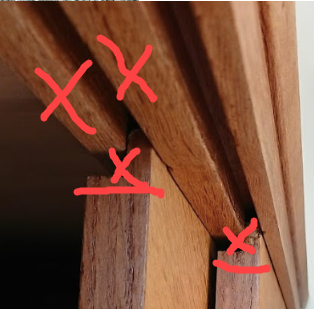I'm looking to lubricate the plastic rails of the sliding doors on a vintage wardrobe. Would regular oil, mineral oil, or something else be the best option?
-
If those are plastic shavings next to that rail, there might be some grit in there which is cutting the plastic. You would have to remove the doors to check and clean the rail and the groove.– Andrew MortonCommented 5 hours ago
-
The leading edge of the nylon slot in the door looks a bit too sharp, which may be causing those plastic shavings– IndigenuityCommented 3 hours ago
4 Answers
Silicone spray works well, doesn't collect dust and doesn't damage anything.
Put it on the top and bottom.
-
1
Nylon glides like that are said to be "self-lubricating". They really shouldn't need much. However, if you do want to slick them up, don't use oil. That'll collect dust and lint and make a big mess, which can end up on your carpet and clothing.
Use a dry lubricant, like wax or Teflon. You want something that dries non-sticky and sheds dirt rather than accumulating it.
-
1
Normally, a bit of 3-in-One oil would do the trick but it looks like the guide on the door is shaving bits of the rail off. Check to see if there are rollers at the top or at the bottom of the doors to see if you can adjust the doors a bit higher so there not pressing so hard down on the rails. Being vintage, you might have to replace some parts.
-
5Those doors really shouldn't be running, or resting on the lower tracks, should they? Those tracks just serve as a guide, with the weight of the door carried by the rollers on the top, right?– SteveShCommented yesterday
-
@SteveSh Running, probably not but maybe just resting litely to prevent the doors from wobbling.– JACKCommented yesterday
-
1The doors are not carried by rollers at the top. See the picture here: imgur.com/a/pB5iply– maxCommented yesterday
-
-
1@JACK Definitely no rollers. I purchased this vintage wardrobe online. It was shipped disassembled.– maxCommented yesterday
The bottom rails appear to be made of PTFE (Teflon). They are meant to slide easily. If the doors are too heavy and they are grinding themselves away, no lubricant will help and most lubricants will make it worse. Spraying PTFE onto a PTFE rail might improve things for one or two cycles, probably not.
Ideally in a sliding door, the weight is supported at the top, and if needed the bottom rails just guide the door straight. In your case it's the opposite! And if the bottom is sticking it will tend to tilt the door so all the weight is on the leading edge of the moving track.
You can't lubricate your way out of this.
You need to remove weight from the bottom tracks.
Your options are:
- [Easiest, least effective] Place handles near the bottoms of the doors and operate them by pulling the doors, not pushing, from a position below center. This will reduce tilting of the door and so reduce the grinding force on the leading edge of the track.
- [PIA, impractical, but effective] Operate only the outer door, by grabbing its ends with both hands and lifting it, either entirely or just to remove most of the weight, while you slide it along. Temporarily you should do this now to reduce damage until you fix it properly.
- [best solution] remove the lip at the top of the doors and all but the outermost top rail, and replace it all with a decent quality track. (That's an example, not a recommendation. Do your homework.) Raise the door by a mm to take weight off the bottom rail, so it is only guiding it along. Maybe remove a tiny bit of the vee at the bottom of the door to create a vertical gap without reducing the amount of side contact (see third pic).





